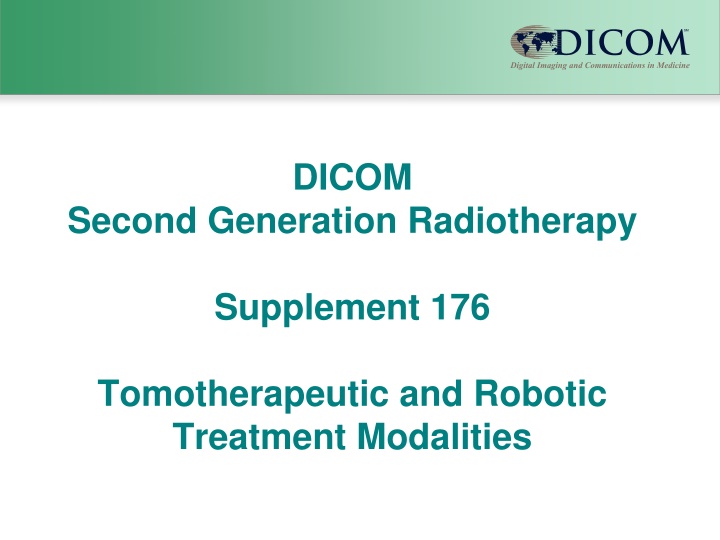Advanced Radiotherapy Techniques and Modalities Overview
This document presents Supplement 176 focusing on second-generation radiotherapy techniques and modalities. It introduces new IOD definitions for external beam radiation therapy machines beyond the traditional C-Arm Linac geometry, addressing shortcomings of first-generation radiotherapy workflow representation. The rationale for the second generation emphasizes the need for a new set of IODs better suited for today's dynamic radiation therapy processes. The overview covers the scope, field of application, and key concepts of the advanced radiotherapy methods discussed in the supplement.
Download Presentation

Please find below an Image/Link to download the presentation.
The content on the website is provided AS IS for your information and personal use only. It may not be sold, licensed, or shared on other websites without obtaining consent from the author.If you encounter any issues during the download, it is possible that the publisher has removed the file from their server.
You are allowed to download the files provided on this website for personal or commercial use, subject to the condition that they are used lawfully. All files are the property of their respective owners.
The content on the website is provided AS IS for your information and personal use only. It may not be sold, licensed, or shared on other websites without obtaining consent from the author.
E N D
Presentation Transcript
DICOM Second Generation Radiotherapy Supplement 176 Tomotherapeutic and Robotic Treatment Modalities
Introduction to Sup 176 Scope and Field of Application Following the definition of the RT Radiation composite IOD for the most common external beam radiation therapy machine (C-Arm Linac), this supplement adds IOD definitions for three external beam radiation therapy machines that do not fit the C-Arm Linac geometry. In this way, the structure of data that is being established for 2nd Generation RT can be maintained while defining the right format of data for these particular machines. 2
Rationale for 2nd Gen General shortcomings of current Radiotherapy Objects in RT 1stGeneration Radiotherapy Workflow Representation: Basically all function points of RT Workflow in one IOD: RT Plan (besides Treatment Recording) No independent IOD for Prescription Not suited for adaptive character of today s radiation therapy processes (1st Generation originated from a model of one-time planning, which is outdated today) Hard to use 1st Generation IODs in a dynamic workflow environment Conclusions: New set of IODs is needed Partitioned along the different function points of the workflow Each object has its dedicated role Extensible for new treatment techniques, positioning technologies, etc. 3
2nd Gen Overview Sup 175 RT Treatment Fraction (Technique-independent) RT Radiation Set IOD Generic Parts of RT Radiation IODs C-Arm Photon RT Radiation IOD C-Arm Electron RT Radiation IOD Modalities of Sup 175 Sup 176 Tomotherapeutic RT Radiation IOD Robotic Multi-Fixed Source RT Radiation IOD Modalities of Sup 176 RT Radiation IOD Future IODs for known Techniques Ion RT Radiation IOD Brachytherapy RT Radiation IOD More Future IODs ... any time as needed New Device A RT Radiation IOD New Device B RT Radiation IOD ... RT Radiation IOD 4
Sup 176 Content Sup 175: Introducing general concepts: see later slides Concept of RT Radiation Set IOD Concepts of RT Radiation IODs Various Payload Concepts like Control Points Dose Accumulation Beam Modifier Macros Introducing one 2nd Gen RT Radiation IOD for: conventional Photon / Electron C-Arm Linacs Sup 176: Introducing three more 2nd Gen RT Radiation IODs for: Tomotherapeutic Treatment Devices Multi-Source Treatment Devices Robotic Treatment Devices based on Sup 175 Concepts represents also template for future additions of new RT Radiation IODs for more treatment devices 5
Tomotherapeutic Devices A.VV.1.6 This machine is characterized by its ability to continuously rotate within a covered gantry (like a CT) while the patient is moved through the bore longitudinally by the treatment table top. It uses a binary MLC for modulating the beam and thus its beam limiting device (a Multi-Leaf Collimator or MLC) only has an in or out setting rather than a millimeter position setting. Tomotherapeutic Radiation IOD Device-specific IOD Content: Photon/Electron radiation type Multi-revolution Arc Treatment (using 2nd Gen Continuous Angle representation) Binary MLC Fractional leaf opening Couch speed IEC 61217-like Device Geometry 6
Robotic Devices A.VV.1.10 This machine characterized by a small linear accelerator mounted on a robotic arm. There is only one source of radiation but it can be directed from a large number of directions that is no longer constrained by mounting on a C-Arm. These directions are achieved by combinations of gantry and table top angles that are being reported by this object. The beam limiting device of this machine can be a fixed cone size or an MLC. Robotic Radiation IOD Device-specific IOD Content: Photon/Electron radiation type Path definitions Definition of treatment along patterns 3D Room Device Geometry Specification of Source and Target point as 3D coordinates 7
2nd Gen Radiation IODs For details regarding the underlying RT Radiation Concepts, please review the presentation for Supplement 175. 8
Contacts Christof Schadt Editor, Co-Chair WG-07 Brainlab AG christof.schadt@brainlab.com Jim Percy Co-Chair WG-07 Elekta jim.percy@elekta.com


![❤[READ]❤ Deep Space Craft: An Overview of Interplanetary Flight (Springer Praxis](/thumb/21511/read-deep-space-craft-an-overview-of-interplanetary-flight-springer-praxis.jpg)




















